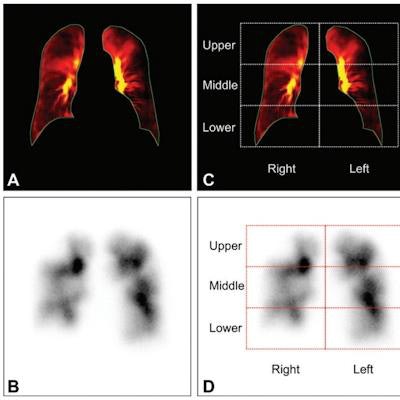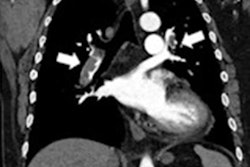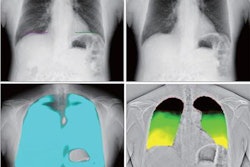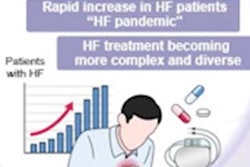
Dynamic chest radiography (DCR) has similar efficacy as lung ventilation profusion (V/Q) scanning for diagnosing chronic thromboembolic pulmonary hypertension (CTEPH), according to a study published November 8 in the journal Radiology.
The findings suggest that there's a way to diagnose CTEPH (that is, high blood pressure in the small blood vessels of the lungs) that doesn't subject patients to the levels of radiation V/Q scanning does, wrote a team led by Dr. Yuzo Yamasaki of Kyushu University in Fukuoka, Japan.
"[One drawback] of V/Q scanning is the exposure of patients to ionizing radiation," the group noted. "[So] a method with greater availability and less radiation exposure for detecting chronic thromboembolic pulmonary hypertension is desirable."
CTEPH is a serious complication of pulmonary embolism and a major cause of pulmonary hypertension, and if left untreated, patient outcomes tend to be poor, the group noted. V/Q scanning has long been used to diagnose the condition, but it has limitations, including high radiation exposure and reliance on the radioisotopes molybdenum-99 (Mo-99) and technetium-99m (Tc-99m) -- both of which have short half-lives and can be in limited supply.
 Images in a 61-year-old woman with chronic thromboembolic pulmonary hypertension. (A) Perfusion map of dynamic chest radiography and (B) anteroposterior view of planar perfusion scintigraphy, with (C, D) corresponding bilateral lung segmentations and (E) chest radiograph. Images and caption courtesy of the RSNA.
Images in a 61-year-old woman with chronic thromboembolic pulmonary hypertension. (A) Perfusion map of dynamic chest radiography and (B) anteroposterior view of planar perfusion scintigraphy, with (C, D) corresponding bilateral lung segmentations and (E) chest radiograph. Images and caption courtesy of the RSNA.Compared with V/Q scanning, DCR has some real benefits according to Yamasaki's team: It is based on traditional x-ray technology, making it easy to perform in general imaging centers alongside conventional chest x-ray; it imparts lower radiation doses; and the exams are shorter.
But DCR's efficacy for detecting chronic thromboembolic pulmonary hypertension isn't clear. To address the knowledge gap, Yamasaki's team compared DCR with V/Q scanning via a study that included 50 patients with pulmonary hypertension (29 with CTEPH and 21 without it) who were screened using DCR and V/Q scanning between December 2019 to July 2021.
The group found that, across a variety of measures, DCR performed comparably to V/Q scanning.
| Comparison of V/Q scanning and DCR for diagnosing chronic thromboembolic pulmonary hypertension | ||
| Measure | V/Q scanning | DCR |
| Accuracy | 94% | 92% |
| Sensitivity | 100% | 97% |
| Specificity | 86% | 86% |
The study results are promising, wrote Dr. John Wandtke and Dr. Katherine Kaproth-Joslin, PhD, both at the University of Rochester Medical Center in Rochester, NY, in an accompanying editorial.
"This ... study ... in conjunction with other recent publications related to DCR imaging, provides radiologists with another imaging technique to quickly screen patients with possible thromboembolic disease," they wrote.



















